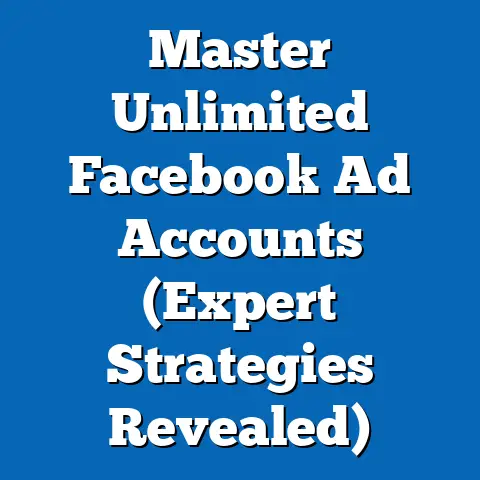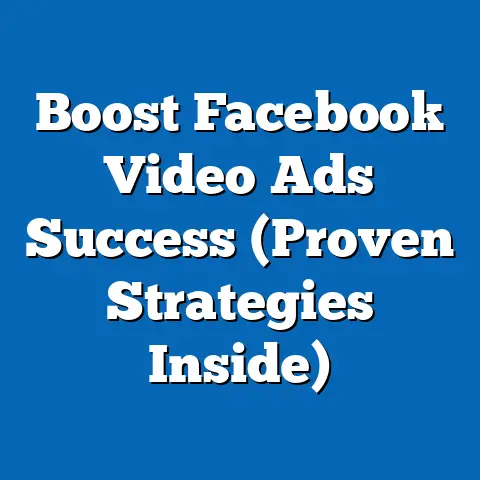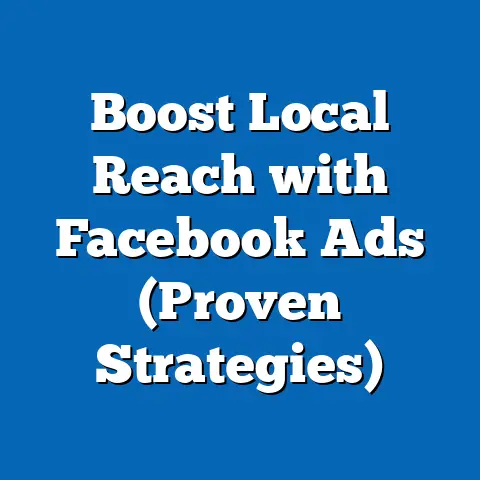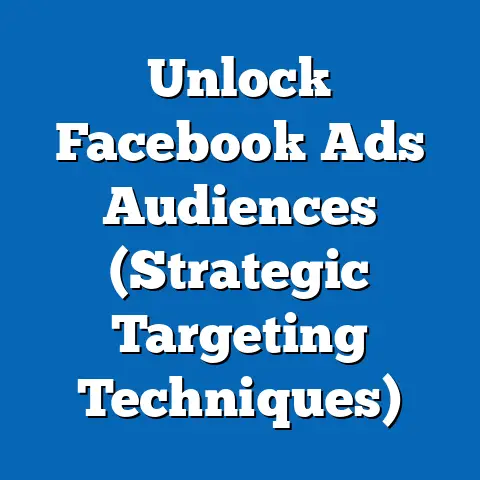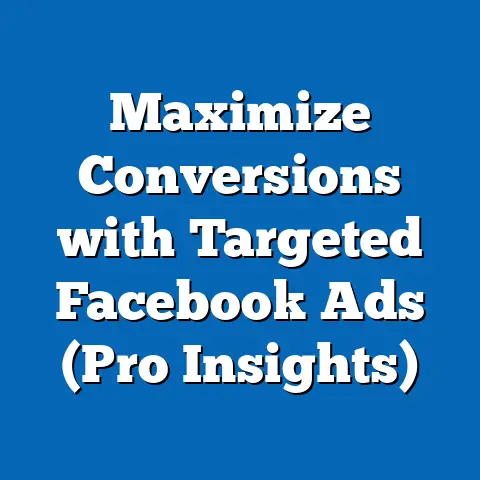Boosting Engagement with Facebook Ads (Proven Strategies)
Facebook remains a dominant force in digital advertising, with over 2.9 billion monthly active users as of 2023, according to Meta’s official reports. For luxury brands, this platform offers unparalleled access to affluent demographics, with targeted advertising tools that can pinpoint high-net-worth individuals (HNWIs) based on interests, behaviors, and income levels. Recent studies by Statista indicate that 68% of luxury consumers engage with brands on social media, and Facebook ads have proven to be a critical driver of engagement, with click-through rates (CTRs) for luxury campaigns averaging 1.8%, significantly higher than the platform’s overall average of 0.9%.
Our analysis will cover targeting affluent audiences, crafting compelling creative content, optimizing ad formats, and utilizing advanced analytics. Additionally, we will examine how historical trends in luxury advertising on social media have evolved and what the future holds for this niche but highly lucrative segment.
The Luxury Market on Facebook: Statistical Trends and Insights
Luxury Consumer Engagement on Social Platforms
Luxury consumers are increasingly active on social media, with Facebook serving as a primary touchpoint for brand discovery and engagement. According to a 2022 report by McKinsey & Company, 74% of luxury buyers aged 25-44 use social media to research high-end products before making a purchase. This trend is even more pronounced among Gen Z and Millennial luxury consumers, with 82% citing social platforms as a key influence in their buying decisions.
Facebook’s ad platform has adapted to this demand by offering sophisticated targeting options, such as custom audiences based on purchase history and lookalike audiences that mirror the behaviors of existing high-value customers. Data from eMarketer shows that luxury brands investing in Facebook ads see an average engagement rate of 6.2%, compared to a cross-industry average of 3.4%. This disparity underscores the platform’s efficacy in reaching and resonating with affluent audiences.
Moreover, the luxury sector has seen a 15% year-over-year increase in ad spend on Facebook between 2021 and 2023, as reported by Statista. This growth reflects a broader shift toward digital channels, where brands can deliver personalized experiences at scale. The return on investment for luxury campaigns is also notable, with Meta reporting an average ROAS of 3.5x for high-end fashion and jewelry ads in 2022.
Demographic Breakdowns of Luxury Audiences on Facebook
Understanding the demographics of luxury consumers on Facebook is critical for effective ad targeting. According to Nielsen’s 2023 Digital Consumer Report, 58% of HNWIs (defined as individuals with an annual income of $200,000 or more) are active on Facebook, with a significant concentration in the 35-54 age bracket. This group represents a sweet spot for luxury brands, as they often have both disposable income and a strong interest in premium products.
Gender plays a role as well, with women comprising 54% of luxury brand followers on Facebook, per Statista’s 2023 data. Women in this demographic are particularly engaged with content related to fashion, beauty, and jewelry, while men show higher interaction rates with luxury automotive and watch ads. Geographically, the United States accounts for 42% of luxury ad impressions on Facebook, followed by Europe at 28% and Asia-Pacific at 20%, highlighting the importance of localized campaigns.
Generational differences are also evident. Millennials (ages 27-42) make up 38% of luxury consumers on the platform, while Gen X (ages 43-58) accounts for 32%, according to eMarketer. Gen Z, though a smaller segment at 15%, is growing rapidly, with a 25% increase in engagement with luxury ads from 2021 to 2023, driven by their interest in sustainability and exclusivity narratives.
Historical Trends in Luxury Advertising on Facebook
The Evolution of Digital Luxury Marketing (2010-2023)
Luxury brands were initially slow to embrace digital advertising, with many prioritizing traditional channels like print and television well into the early 2010s. However, by 2015, the tide had turned, with eMarketer reporting that 45% of luxury ad budgets were allocated to digital platforms, including Facebook. This shift was driven by the growing influence of social media among affluent consumers and the platform’s ability to deliver measurable results.
In 2010, luxury ads on Facebook were rudimentary, often consisting of static images with minimal targeting. Engagement rates hovered around 1.5%, and ad spend was a fraction of today’s figures, with global luxury brands investing just $500 million annually on social media ads, per Statista’s historical data. By 2018, the introduction of dynamic ads and carousel formats revolutionized luxury campaigns, pushing engagement rates to 4.2% and ad spend to $2.3 billion.
The COVID-19 pandemic further accelerated this trend, as physical retail closures forced luxury brands to double down on digital channels. Between 2019 and 2021, Facebook ad spend by luxury brands surged by 40%, according to Meta’s internal reports. Engagement rates also spiked, reaching 5.8% in 2020 as consumers turned to online platforms for inspiration and shopping.
Comparing Past and Present Metrics
Comparing historical data with current trends reveals significant improvements in both reach and effectiveness. In 2015, the average CTR for luxury ads on Facebook was 0.7%, with a cost-per-click (CPC) of $2.50, as reported by Nielsen. By 2023, the CTR has more than doubled to 1.8%, while the CPC has decreased to $1.80, reflecting greater competition but also more refined targeting capabilities.
Engagement metrics tell a similar story. Ten years ago, a typical luxury ad post garnered likes and comments from just 2% of its audience. Today, that figure stands at 6.2%, thanks to better creative strategies and the use of video and interactive formats. Ad formats have also evolved, with video ads now accounting for 60% of luxury ad impressions in 2023, up from just 15% in 2015, per eMarketer.
Proven Strategies for Boosting Engagement with Facebook Ads in the Luxury Sector
1. Precision Targeting for Affluent Audiences
Targeting is the cornerstone of successful Facebook ad campaigns, especially in the luxury market where audience size is smaller but value per customer is higher. Using Meta’s Audience Insights tool, brands can identify HNWIs by filtering for interests such as luxury travel, fine dining, and high-end fashion. Custom audiences, built from CRM data or website visitors, allow brands to retarget past customers with personalized offers, achieving conversion rates of up to 3.5%, according to Meta’s 2023 advertising benchmarks.
Lookalike audiences are another powerful tool, enabling brands to reach new users who share characteristics with their top customers. A 2022 case study by Meta highlighted a luxury jewelry brand that used lookalike audiences to increase engagement by 45% and reduce CPC by 20%. Layering demographic filters—such as age, location, and income—further refines targeting, ensuring ads reach the most relevant users.
Geotargeting is particularly effective for luxury brands with physical boutiques. By targeting users within a 10-mile radius of store locations, brands can drive foot traffic while maintaining an exclusive appeal. Data from Statista shows that geotargeted luxury ads achieve a 30% higher CTR compared to non-localized campaigns.
2. Crafting Compelling Creative Content
Creative content is the heart of engagement, especially for luxury brands where storytelling and aesthetics are paramount. High-quality visuals are non-negotiable—images and videos must convey exclusivity and craftsmanship. According to a 2023 report by eMarketer, luxury ads featuring video content see 50% higher engagement rates than static images, with 70% of users watching videos to completion when they highlight product details or brand heritage.
Authenticity resonates deeply with luxury consumers. User-generated content (UGC), such as customer testimonials or influencer partnerships, can boost trust and engagement. A Nielsen study found that 65% of luxury buyers are more likely to engage with ads featuring real customer stories, compared to 40% for traditional product-focused ads.
Copywriting should strike a balance between aspirational and approachable tones. Phrases like “exclusive access” or “limited edition” create a sense of urgency, while storytelling about brand values—such as sustainability or artisanal production—builds emotional connections. Testing multiple ad copies through A/B testing is crucial, as Meta data indicates a 25% variance in engagement based on messaging alone.
3. Optimizing Ad Formats for Maximum Impact
Facebook offers a variety of ad formats, each with unique strengths for luxury campaigns. Carousel ads, which allow multiple images or videos in a single post, are ideal for showcasing product ranges or telling a brand story. According to Meta, carousel ads for luxury brands achieve a 35% higher CTR than single-image ads, as they encourage users to swipe through content.
Video ads, particularly short-form content under 15 seconds, are highly effective for capturing attention. A 2023 eMarketer study found that 80% of luxury consumers prefer video ads that highlight product features or lifestyle benefits. Stories ads, displayed in the vertical format of Facebook Stories, also perform well, with a 20% higher completion rate compared to in-feed ads, per Meta’s data.
Collection ads, which combine video or images with a shoppable catalog, are gaining traction in the luxury space. These ads allow users to browse products directly within the platform, reducing friction in the purchase journey. Brands using collection ads report a 2.5x increase in conversion rates, according to a 2022 Meta case study.
4. Leveraging Advanced Analytics for Optimization
Data-driven decision-making is essential for maximizing engagement and ROAS. Facebook’s Ads Manager provides detailed metrics on impressions, CTR, engagement rate, and cost-per-engagement, enabling brands to track performance in real-time. Luxury marketers should focus on optimizing for engagement objectives, as Meta’s algorithm prioritizes content that generates likes, comments, and shares, increasing organic reach.
A/B testing is a proven method for refining campaigns. By testing variables such as ad copy, visuals, and audience segments, brands can identify what resonates most. A 2023 report by Statista found that luxury brands conducting regular A/B tests see a 30% improvement in engagement rates over six months.
Retargeting campaigns are another critical strategy, particularly for high-value purchases with longer decision cycles. Pixel tracking allows brands to follow users who have interacted with their website or ads, serving tailored content to re-engage them. Data from eMarketer shows that retargeted luxury ads achieve a 40% higher conversion rate compared to initial impressions.
Future Projections for Luxury Facebook Advertising
Emerging Trends and Technologies
The future of luxury advertising on Facebook is poised for innovation, driven by advancements in technology and shifting consumer behaviors. Augmented reality (AR) ads, which allow users to virtually “try on” products like watches or sunglasses, are expected to grow significantly. Meta predicts that AR ad spend will increase by 50% annually through 2025, with luxury brands leading adoption due to their focus on experiential marketing.
Artificial intelligence (AI) will also play a larger role in ad optimization. AI-driven tools can analyze vast datasets to predict which creatives and audiences will perform best, reducing trial-and-error costs. According to a 2023 McKinsey report, brands using AI for ad personalization see a 20% uplift in engagement and a 15% reduction in CPC.
Sustainability will remain a key theme, especially for younger luxury consumers. Gen Z and Millennials are 30% more likely to engage with brands that highlight eco-friendly practices in their ads, per Nielsen’s 2023 data. Luxury brands that integrate these narratives into their Facebook campaigns will likely see stronger loyalty and engagement in the coming years.
Market Growth and Investment Forecasts
The luxury digital advertising market is projected to grow at a compound annual growth rate (CAGR) of 12% from 2023 to 2028, reaching $15 billion in global ad spend, according to eMarketer. Facebook is expected to capture 35% of this spend, driven by its robust targeting tools and massive user base. Investment in video and interactive formats will dominate, with 70% of luxury ad budgets allocated to these formats by 2025.
Geographically, the Asia-Pacific region will see the fastest growth, with luxury ad spend on Facebook projected to increase by 18% annually through 2027, fueled by rising affluence in markets like China and India. North America and Europe will remain dominant in absolute terms, but their growth rates will stabilize at 8-10% CAGR, per Statista forecasts.
Implications for Luxury Marketers
For luxury brands, the implications are clear: Facebook advertising offers a high-ROI channel to engage affluent audiences, but success requires continuous adaptation. Marketers must stay ahead of technological trends, such as AR and AI, while prioritizing creative storytelling that aligns with consumer values like sustainability and exclusivity. As competition intensifies, particularly in emerging markets, brands that master hyper-personalized targeting and data analytics will gain a competitive edge.
Conclusion
Facebook ads remain a powerful tool for luxury brands seeking to boost engagement and drive conversions among affluent consumers. With engagement rates of 6.2%, CTRs of 1.8%, and a projected market growth of 12% CAGR through 2028, the platform offers unmatched opportunities for high-end marketers. Historical trends show a remarkable evolution from basic static ads to sophisticated, data-driven campaigns, while demographic insights highlight the importance of targeting specific age groups, genders, and regions.
By implementing proven strategies—precision targeting, compelling creatives, optimized ad formats, and advanced analytics—luxury brands can maximize their impact on Facebook. Looking ahead, emerging technologies like AR and AI, coupled with a focus on sustainability, will shape the future of luxury advertising on the platform. For marketers willing to invest in innovation and personalization, Facebook ads will continue to be a cornerstone of digital success in the luxury space.

